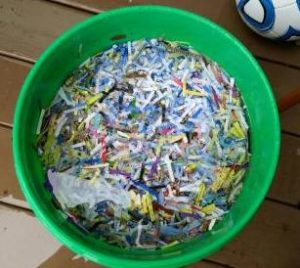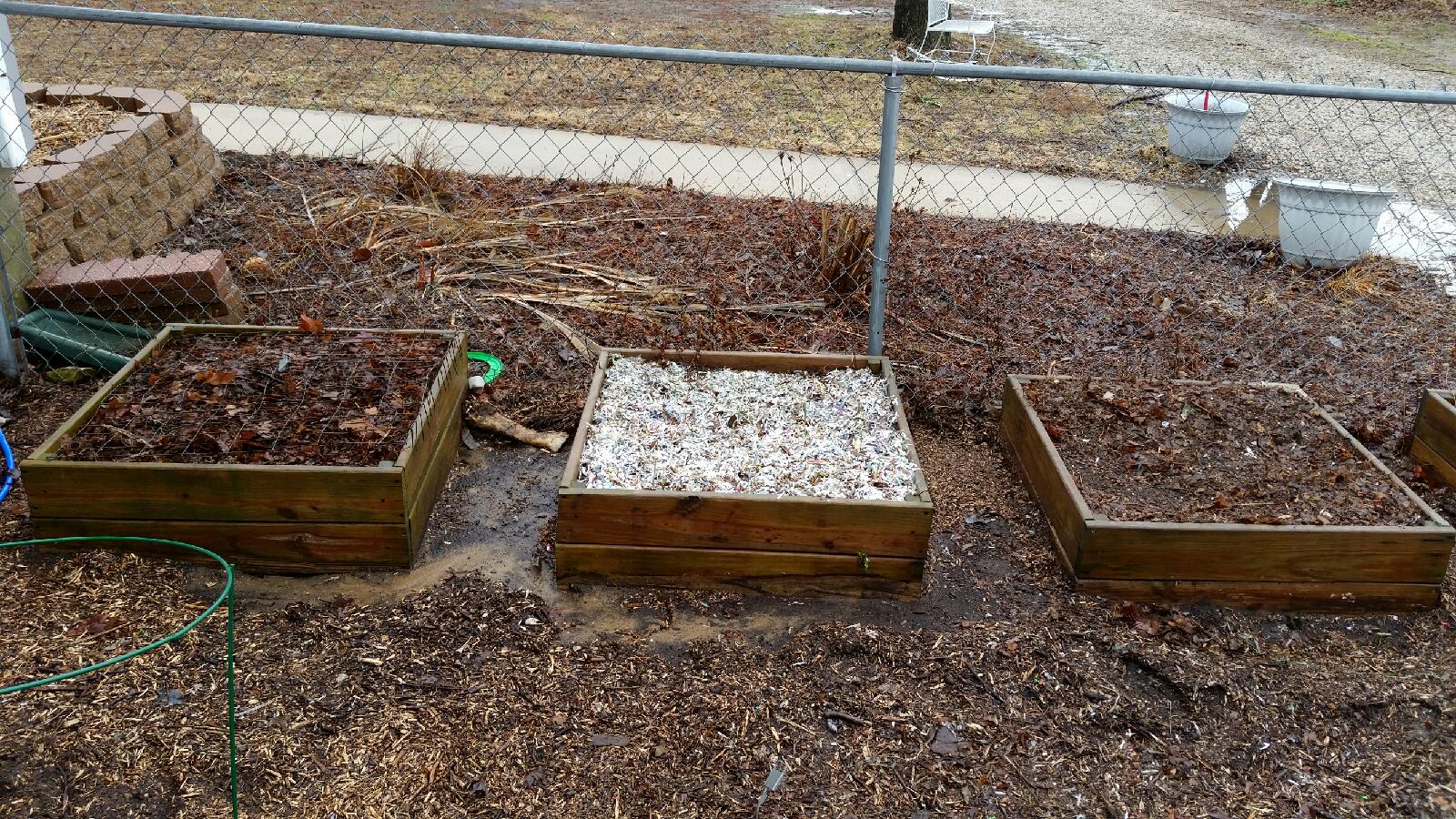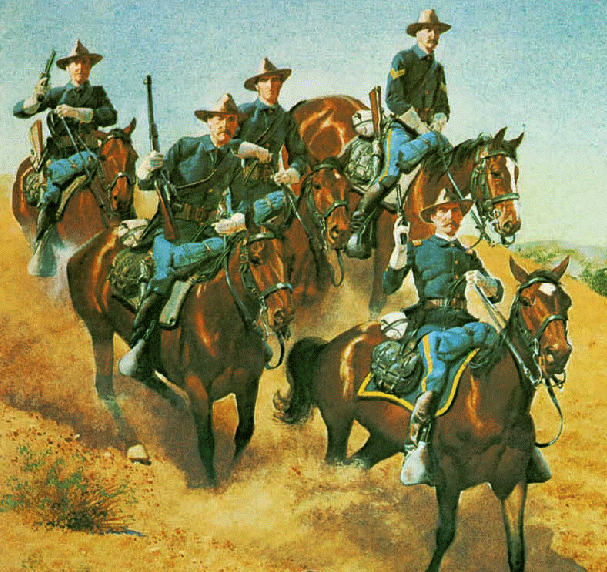Most gardeners who use raised beds quickly fall in love with mulches. A thick layer of mulch on top of the soil preserves moisture, suppresses weed growth, and can even add nutrients to the soil all year long. A good mulch can reduce your garden “maintenance” time by half.
But what’s the best material to use for mulch? You can buy a plastic or cloth sheet mulch that suppresses everything but your plants. In recent years, wood chips have gained popularity. Chopped straw is effective but can be expensive. Shredded leaves are an old standby that never goes out of style. But I would like to recommend a mulch you’ve probably never heard of: shredded paper.
Most of us have too much junk mail, receive too many magazines… in short, we have a ton of paper around the house that we throw away or burn (or if you read David the Good, compost!). Rather than looking for ways to get rid of it, you can put it to good use while it rots naturally, adding carbon to the soil. It holds its form wonderfully. Worms love it. And perhaps best of all, my dog won’t dig in it so my young plants stay safe from that bone half-burying menace.
The steps to using it are few, the questions that arise are many, so let’s deal with the simple first.
How to create and use shredded paper mulch in three easy steps:
- Run your junk paper through the shredder.
- Soak it in a 5-gallon bucket of water overnight.
- Slop it around your plants three inches thick, leaving an inch of space around their stems.

That’s it. Once it dries, your mulch will hold its form for months, while allowing water to seep through. If you slop on at least two inches, you’ll see nary a weed. At harvest time, I throw the half-rotted paper into the compost cage where it will quickly convert to compost for soil amendment. It’s fast, it’s simple, and it’s good for your soil.
Now, the obvious questions, also known as “the reasons everyone else will tell you not to do this”:
Do you shred printed paper?
Before I started, I looked long and hard at that, because I had read that inks weren’t safe, newspaper was bleached, all that fun stuff. But while everyone was saying it, very few people actually provided a source I could check. It was just one of those things that everyone knew. Or at least said.
Having worked in a print shop, I was suspicious of the claim that modern inks are dripping with heavy metals just waiting to kill you. The vast majority of colored inks today are made from soy, and the ‘glossy’ paper is generally covered with kaolin clay, not plastic. Kaolin is inert and will break down easily if your paper is shredded.
I shred junk mail, newspapers, magazines, cardboard, even old books. I strip out plastic envelope windows, plastic tape, obvious metal inks (magnetic and fluorescent), but otherwise I don’t worry about “printed stuff” too much.
What about BPAs and other pollutants?
In contrast to the air where BPAs can last a long time, BPA in the ground has a half-life measured in hours:
So shredding that Walmart receipt is probably ok.
PCBs are another issue that worries people. They are found in trace amounts in inks and paper. But that’s because they are found in trace amounts everywhere:
Is there *any* risk that something bad for you is going to get into your shred through inks or paper?
Absolutely.
But as there’s no way to completely avoid pollutants, it’s really a matter of risk management. I look at it this way: if you don’t worry today about your kid chewing on a magazine page, there’s no reason for you to worry that he’ll be harmed when that same page is shredded, rotted, run through an earthworm or pill bug**, then taken up by a plant that then goes into his mouth.
Does paper mulch provide any nutrients?
Not in the way you might think. Paper is pretty barren, nutritionally. But as it rots, its adds carbon to the soil. And carbon is fundamental to soil fertility. Organic carbon improves soil structure, which helps plants take up minerals more effectively. So while it doesn’t feed your plants directly, it helps your plants to eat.
Doesn’t it blow all over the place?
Rain doesn’t faze it, wind doesn’t move it. Dumping a bucket of dry shred would have that obvious result. But after soaking it, the paper sticks together, and once it’s dried it becomes nearly impossible to pull out individual pieces. If you put it around plants like garlic that die back in the winter, you’ll have a hole in the spring that the plant can grow through again.
Isn’t it ugly?
Well, my plants have never complained about that. Perhaps it makes them look better by comparison. But if you are worried about the acid-trip color scheme in the garden, it’s perfectly ok to put a layer of prettier mulch over the top of it. Shredded paper mulch won’t be offended: it will do its job just the same.
* Irony alert: if you want to keep PCBs out of your garden, bury the newspaper there instead of burning it.
** Which bugs remove heavy metals, like cadmium, from the soil.










5
> I strip out plastic envelope windows, plastic tape, obvious metal inks (magnetic and fluorescent), but otherwise I don’t worry about “printed stuff” too much.
Thanks for the article and addressing the concern about inks. Could you expand on what the obvious metal inks are? I plead ignorance on what is obviously metal.
Magnetic inks used to be used on checks, so if you have boxes of old checks your are getting rid of, I wouldn’t use those. I believe that current checks use regular ink and optical scanners instead of magnetic, but I’m not sure — it’s been a while since I was in banking. Other things I avoid are florescents, stuff that glows in the dark or changes colors, that sort of thing. Not all of them will have metal in them – and I don’t know of any way to be sure one way or the other. But stuff that looks “not normal” it’s ok to toss.
“Obvious metal inks” is probably poor wording on my part. “Inks that are obviously different than normal and so might have metals in them” would have been better.
MOTW posts need a Gardening category.
Genius post. Sharing with my son’s agriculture teacher. He teaches a number of alternative growing methods, but I’ve never seen him try this.
Thank you!
I shall go add it immediately.
Thank you, sir!
[…] El Borak at Men of the West has posted a good article on using shredded paper as mulch: […]
Interesting post! I use shredded paper in my garden as well, mixing it with food waste which I bury. Regarding this point:
> I strip out plastic envelope windows,
My information is that those “plastic” windows are in fact cellophane, which is made from wood, and will biodegrade quickly.
Sweet! I’ll check that out. The simpler, the better.
The best part of the article was the reasoned discussion of potential pollutants! I love the garden tip and will be using it.
Better than burning it!